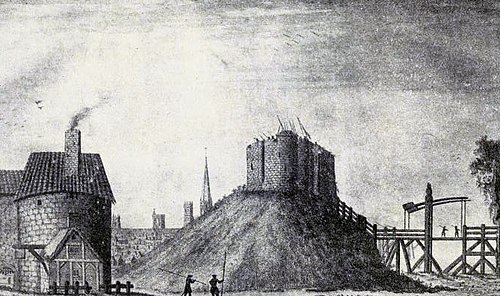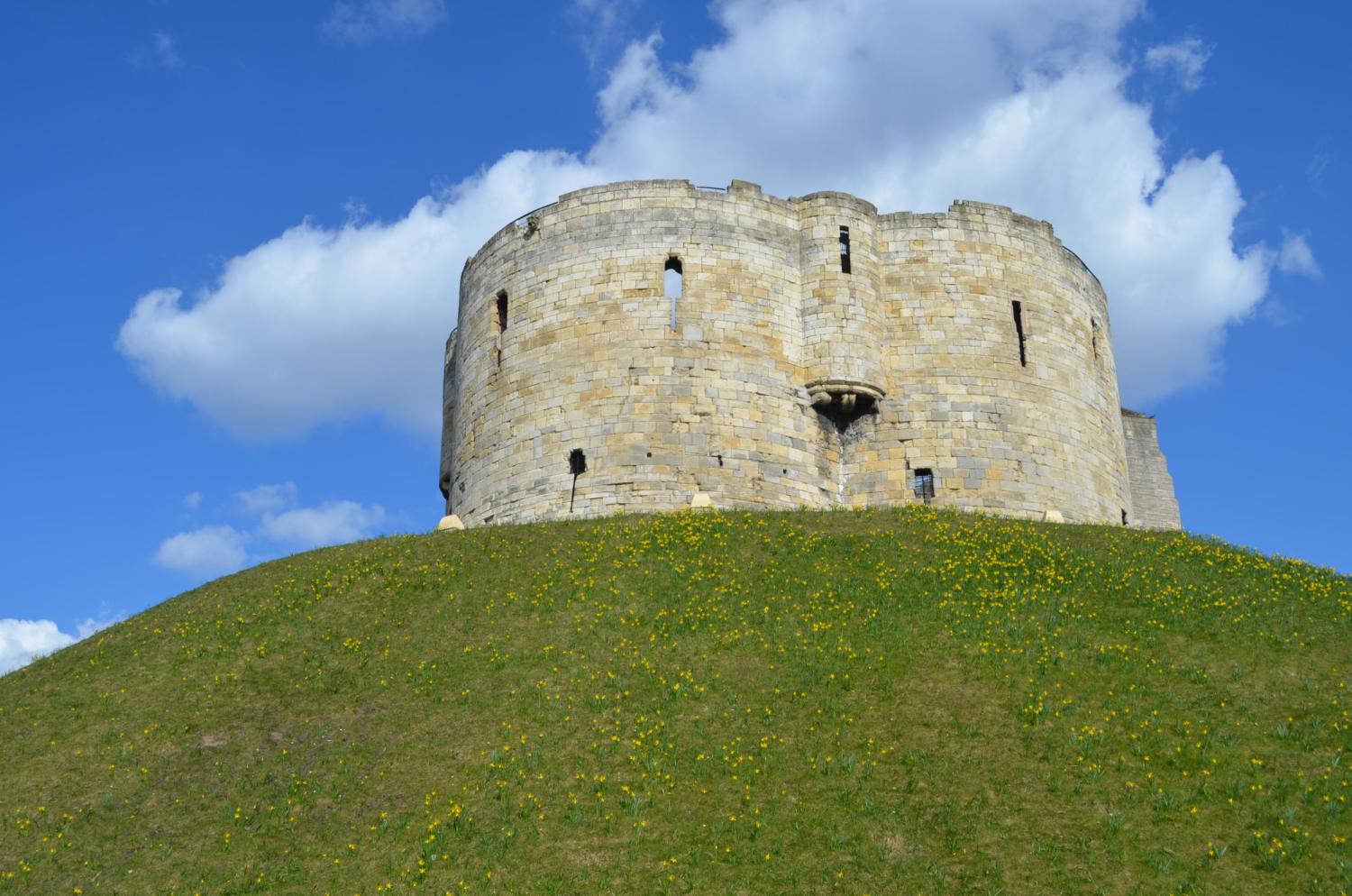By Poppy George
This month our Time Travel article is brought to you by Poppy George, who came to Your Local Link for a work experience placement. Read on to discover all the gory details of Clifford’s Tower throughout the centuries!
York castle, known more commonly as Clifford’s Tower, is one of York’s most iconic and historic buildings. Built in 1068, by William the Conqueror, Clifford’s tower has been a staple of the city for centuries and is a popular tourist destination for visitors to York. But what is the real hidden history of a place known by many.
York castle is a hastily built motte and Bailey castle, constructed in order to ensure Norman control, that was built alongside another castle in York on Baile Hill (which was later destroyed and now an empty man made hill on the south side of the city towards the river Ouse). The castle has endured many different hardships over the years, for example, in the Norman period the castle was briefly captured by a Danish fleet and a mob of local rebels and partially dismantled. When the castle was rebuilt after the harrying of the north, it is said to have had ‘halls, kitchens, a chapel, barracks, stores, stables, forges and workshops’.

During the reign of Henry II, the King made 4 different visits and the castle was used as the site where King Henry II received the homage of William the Lion of Scotland in 1175. However, it was also during this time period that York castle was the site of one of the worst pogroms (massacre) in the entire medieval period. Richard I was king and had every intent of joining the crusades which inflamed an anti-jewish sentiment across the country. This came to a head here in York in 1190. Richard De Malbis owed a lot of money to a Jewish merchant called Aaron of Lincoln and he exploited an accidental house fire in order to incite a local mob to attack the house and home of a Jewish employee of Aaron.
Josce of York (a local Jewish leader) led Jewish families to the castle in order to take refuge. The mob surrounded the castle and on the 16th of march 1190, the Jewish population of York saw no other way but to commit suicide in the castle. The castle was set on fire, to make sure the mob couldn’t mutilate their bodies, and the very few who surrendered were killed by the mob. 150 people died in total and the castle was rebuilt, higher this time, and again out of wood.
Clifford’s Tower was used very frequently during King John’s and King Henry the 3rd’s reigns and it was during this time that the first record of the castle being used as a gaol (prison) was recorded. In 1228, a gale destroyed the wooden keep on the motte during a visit by King Henry III and in 1244, the king ordered the castle to be rebuilt in white limestone. The work was completed in 1270 and the main castle atop the motte (the hill) was designed in the same shape we see today. Furthermore, the castle’s role as a gaol was also expanded to house a wide range of prisoners. However, prison breaks were common during this time, for example, in 1298 when 28 prisoners banded together and successfully broke free. The castle was also the site of many rebel executions after the battle of Boroughbridge.
From 1400 onwards, the castle fell into a state of disrepair and the King’s councillors no longer used the building for work or accommodation in York. The tower took over from Micklegate bar as the place most frequently used for executions, like the execution of political leader, Robert Aske, as ordered by Henry VIII. The Clifford family also became the hereditary constables of the castle, and some people believe that Clifford’s Tower took its name from them.
Henry Clifford repaired the castle and remodeled it just in time for the English civil war to kick off, in which the tower became the ‘Northern Capital’ for the Royalist Army. On the 23rd April 1644, parliamentarian forces commenced the siege on York and attempted to take control of the city and castle. On July 14th of that year, the city and castle were surrendered to the parliamentarians, who permitted the royalists to march out with full honours.
After the restoration of Charles II, repairs were made and the tower became a magazine for storing gunpowder and shot (ammunition). On St George’s Day 1684, an explosion in the magazine destroyed the entire interior. The explosion was ruled as an accident, but many historians believe the explosion was started on purpose. The fire is the cause of the current slightly pink discolouration to some of the towers bricks.
In 1701, a decision was taken to redevelop the old Bailey area and move some of the gaol down into the previously disused area, in the form of a women’s prison and a debtors prison. He gaol was in operation as a county prison until 1900. However, in 1890, the police commissioner’s agreed to declare Clifford’s Tower as a national monument and the building is owned by English Heritage who made repair to the castle as turned it into a tourist attraction, that people can pay to head up to the top and see one of the best views on the city as well as turning the prisons below Clifford’s Tower into the castle museum where you can learn more about the rich history of the City of York.
York is known for being one of the most haunted cities in the country and Clifford’s Tower is no exception. From bleeding stones to phantom footsteps, Clifford’s Tower has its fair share of ghost stories.

Roger De Clifford, who some believe inspired the name of the castle, was the 2nd baron de Clifford and the 2nd Lord of Skipton. He inherited the title from his father Robert ww Clifford who died at the battle of Bannockburn in 1314.
He took part in a rebellion against King Edward II’s favourite, Hugh Despenser the younger and ultimately against King Edward himself. During the battle of Boroughbridge between the rebels and the king’s forces in march 1322, Roger was severely injured during the battle and was forced to surrender.
He was taken to York where he was held until his execution on, what many believe to have been, the 23rd of march 1322. He was hung and left in a cage for 1 year and 1 day. Many soldiers for centuries after his execution reported sightings of Roger haunting the castle as do some people today.
Another example of the haunted history of Clifford’s Tower comes following the awful jewish massacre of 1190. In the years following the massacre after the walls were replaced by white limestone, residents reported seeing deep red stones spreading across the stone walls.
Many claimed this to be blood flowing down the sides of the castle as a reminder of the massacre and a haunting sent by a ghost but the officials in the area later confirmed this to be due to iron oxide rust.
However many were quick to point out that none of the other stone mined from the same area exhibited signs of iron oxide rust and many today still believe this to have been a supernatural haunting from the ghosts of the jewish population of York that died that night.
Furthermore staff have reported hearing sounds of knocking coming from the walls and ceiling as well as the sound of what resembles children running through the courtyard. Some tourists have even claimed to have seen ghosts in the background of their photographs.
Whether you believe in the ghost stories or not, York castle was named as one of the most haunted sites across the country by English Heritage and the continued eerie sightings pose and interesting (and terrifying to some) question on the reality of these claims.
All images sourced from Wikipedia Commons.











Add a comment